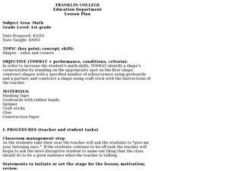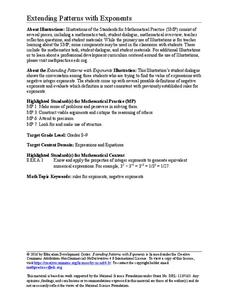Curated OER
Divisibility Tests
It's not a short cut, just good old fashion number sense, but kids will love it. This presentation does a wonderful job describing the divisibility rules by showing how each one works, reviewing the rules as a collective and providing an...
Math Worksheets Land
Patterns of Association (Using Data Tables) - Step-by-Step Lesson
This worksheet belongs to a four-part resource that gathers information from data tables to calculate percentages. The page introduces one problem and shares an explanation to the answer.
Curated OER
Patterns of Evolution and Selection
Can your young biologists interpret population graphs, match macroevolution patterns and descriptions, and answer multiple choice questions about evolution? Find out with a comprehensive three-page quiz covering some specific examples of...
Math Worksheets Land
Patterns of Association (Using Data Tables) - Independent Practice Worksheet
Here is a worksheet that belongs in a four-part resource that has learners practice using data tables to calculate percentages. The page has ten problems with different data tables asking to find different percents.
Curated OER
Shapes - Sides and Corners
Students identify a number of different shapes and their corners and sides. Using a cut out of the shape, they stand on the appropriate shape on the floor and count the sides and corners. They use a geoboard to construct their own shapes...
Curated OER
Graphing Ordered Pairs
Here is graphing worksheet which has pupils graph ordered pairs and label the axis. They graph five ordered pairs and then interpret the data in the graph.
Curated OER
Writing and Reading Center #2: Sentence Combining
Still plagued by short, choppy sentences in the writings of your class members? Here's another practice set that asks learners to combine a series of short sentences into a single, more interesting one. Could be used as an in-class drill...
Curriculum Corner
Roll, Read, and Color
Familiarize young readers with consonant digraphs using a collaborative phonics activity. Working in pairs, children take turns rolling a die and reading a word from the included chart that corresponds to the number they rolled. Each...
World Wildlife Fund
Take 6
Investigate the various properties of the number six with this elementary math lesson. From simple addition, subtraction, multiplication, and division problems to the creation of hexagonal tessellations, this lesson covers all aspects of...
Curated OER
Children's Literature Across the Curriculum Ideas-Two Eyes, A Nose, and A Mouth
Young scholars read Two Eyes, A Nose, and A Mouth by Roberta Grobel Intrater. They complete a variety of cross-curricular activities surrounding faces and facial features. Included are reading, art, math, science, writing, social...
Curated OER
Count by 5s, 10s, and 100s
These number sequences are missing digits! Each of the six has one missing number and scholars must figure out what it is. Here's the pattern, though: all of these sequences involve counting by 5s, 10s, and 100s. Learners add one of...
Curated OER
Mentally Add and Subtract 10 or 100
Find the missing digits in these number sequences. Each of the ten has one missing number and scholars must figure out what it is. Here's the pattern: all of these sequences involve counting by 10s. Learners add or subtract 10 to...
Curated OER
Counting Practice
Young counters practice their skills in these two visual problems. First, they examine a number sequence beginning at 10 with a few filled in. They must count by 10s to fill in the rest of the pattern. Next, learners count the bubbles...
Curated OER
Two Sides, Same Coin: How Political Beliefs Influence Language Use
Learners read several magazine articles on the same topic written from different political perspectives, paying particular attention to the diction, syntax, and arguments presented in support the point of view expressed. They then select...
Curated OER
Comparing Two Improvisations
Jazz improvisation can be difficult to listen to for some music enthusiasts, however there are patterns and characteristics that can be analyzed. They use this Venn diagram to aid them in comparing two improvisational pieces, where they...
Curated OER
Counting by 1s Puzzle Worksheet
This dog is apparently quite upset that he is separated from his bone; can your learners use their counting skills to guide him back to it? The hundreds chart just took a fun twist! Scholars start at one on the bottom of the chart, and...
Curated OER
Hands Up Math
Students engage in a lesson that is concerned with the concept of using all four operations in order to create numerical expressions. They practice creating various patterns of problems that could be solved. The expressions are works of...
DK Publishing
10 Times Table
Can scholars find the pattern as they multiply by 10? Third graders learn the beauty of number patterns as they shade in each multiple of ten in a hundreds chart. They complete 10 number sentences multiplying 10 by the numbers 1-10 (one...
EngageNY
Why Do Banks Pay YOU to Provide Their Services?
How does a bank make money? That is the question at the based of a lesson that explores the methods banks use to calculate interest. Groups compare the linear simple interest pattern with the exponential compound interest pattern.
Education Development Center
Extending Patterns with Exponents
Don't think negatively about exponents. Young mathematicians dissect a fictional conversation between pupils trying to evaluate an expression with a negative exponent. This allows them to understand the meaning of negative exponents.
Noyce Foundation
Between the Lines
Explore linear and square dimensions by comparing areas of similar figures. A creative set of five activities designed for elementary through high school classes asks young scholars to compare areas of specific polygons. The first two...
Willow Tree
Arithmetic and Geometric Sequences
Old mathematicians never die; they just lose some of their functions. Studying sequences gives scholars an opportunity to use a new notation. Learners write functions to model arithmetic and geometric sequences and use them to find new...
CK-12 Foundation
Multiplying Polynomials
Help your class find patterns in polynomial multiplication. Pupils multiply a trinomial by a binomial using a graphic organizer. They respond to questions about patterns observed in polynomial multiplication before a discussion question...
Education Development Center
Integer Combinations—Postage Stamps Problem (MS Version)
Number patterns can seem mysterious. Help your learners unravel these mysteries as they complete an intriguing task. Through examination, collaborative groups determine that they are able to produce all integers above a certain value by...
Other popular searches
- Geometric Number Patterns
- Extending Number Patterns
- Fibonacci Number Patterns
- Math Number Patterns
- Number Patterns Worksheets
- Odd and Even Number Patterns
- Number Patterns in Math
- Ab Number Patterns
- Looking for Number Patterns
- Recognizing Number Patterns
- Number Patterns and Sequences
- Patterns Hundred Chart

























